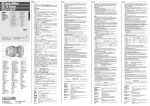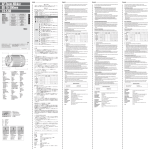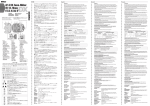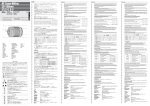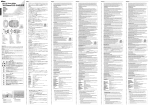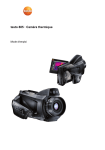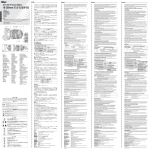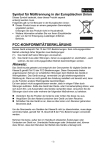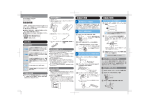Download Nikon Zoom Wide Angle-Telephoto AF Zoom Nikkor 24-85mm f/2.8-4.0D IF Autofocus Lens - AF24-85_2.8
Transcript
日本語 AF Zoom-Nikkor 24-85mm f/2.8-4D IF 使用説明書 Instruction Manual Bedienungsanleitung Manuel d’utilisation Manual de instrucciones Manuale di istruzioni English 安全上のご注意 はじめに ご使用の前にこの「安全上のご注意」をよくお読みのうえ、正しくお使いください。製品を安全に正しく使用 していただき、あなたや他の人々への危害や財産への損害を未然に防止するために、重要な内容を記載して います。お読みになった後は、お使いになる方がいつでも見られる所に必ず保管してください。 表示について ― 付属アクセサリー Accesorios estándar 72mmスプリング式前キャップ 裏ぶた LF-1 バヨネットフード HB-25 Tapa frontal a presión de 72 mm Tapa trasera de objetivo LF-1 Parasol de bayoneta HB-25 Standard accessories Accessori in dotazione 72mm snap-on front lens cap Rear lens cap LF-1 Bayonet hood HB-25 Tappo anteriore da 72mm dia. Tappo posteriore LF-1 Paraluce a baionetta HB-25 Serienmäßiges Zubehör 表示と意味は次のようになっています。 警告 この表示を無視して、誤った取り扱いをすると、人が死亡または重傷を負う可能性が想定される 内容を示しています。 注意 この表示を無視して、誤った取り扱いをすると、人が傷害を負う可能性が想定される内容および 物的損害の発生が想定される内容を示しています。 Jp En De Fr Es It Ck Ch 記号は、禁止(してはいけないこと)の行為を告げるものです。図の中や近くに具体的な禁止内容(左 図の場合は分解禁止)が描かれています。 ●記号は、行為を強制すること(必ずすること)を告げるものです。図の中や近くに具体的な強制内 容(左図の場合は電池を取り出す)が描かれています。 感電したり、異常動作をしてケガの原因となります。 接触禁止 感電したり、破損部でケガをする原因となります。 カメラの電池を抜いて、販売店または当社サービス機関に修理を依頼してください。 すぐに修理依頼を 熱くなる、煙が出る、こげ臭いなどの異常時は、速やかにカメラの電池を取り出すこと 警告 電池を取る 使用禁止 そのまま使用すると火災、やけどの原因となります。電池を取り出す際、やけどに十分注意 してください。電池を抜いて、販売店または当社サービス機関に修理を依頼してください。 発火したり感電の原因となります。 感電注意 プロパンガス・ガソリンなど引火性ガスや粉塵の発生する場所で使用すると、爆発や火 災の原因となります。 失明や視力障害の原因となります。 注意 使用説明書の内容が破損などによって判読できなくなったときは、当社サービス機関にて新しい使用説明書をお求めください(有料)。 FUJI BLDG., 2-3, MARUNOUCHI 3-CHOME, CHIYODA-KU, TOKYO 100-8331, JAPAN 保管注意 Printed in Japan TT5A02000901(K480)80 8MNJA774-05 ケガの原因になることがあります。 ニコンF6、F5、F4、F3シリーズカメラボディには、多種類のファインダースクリーンがあり、レ ンズのタイプや撮影条件に合わせて最適なものを選べます。このレンズに適したファインダースクリ ーンは、表のとおりです。(なお、ご使用に際しては、必ず、各カメラボディの使用説明書も併せて ご参照ください。) 使用しないときは、レンズにキャップをつけるか太陽光のあたらない所に保管すること 最小絞りロックレバー(図B) 太陽光が焦点を結び、火災の原因になることがあります。 プログラムオートやシャッター優先オートによる撮影時は、絞りリングを最小絞りに固定しておくことが できます。まずレンズの絞りリングを回し、最小絞り (最も大きい数値)を絞り指標に合わせます。次に、 最小絞りロックレバーを絞りリングの方向にスライドして2つのオレンジ指標を合わせます。これで絞り リングは最小絞りでロックされます。ロックレバーを反対方向にスライドするとロックは解除されます。 転倒したりぶつけたりしてケガの原因になることがあります。 開放F値の変化と2つの絞り指標(図C) ■ ■ ■ ■ ― ― ― ― ◎ ◎ ◎ ― (+0.5) このレンズはズーミングにより、開放F値が最大約1段変化します。 TTL露出計内蔵カメラの場合、カメラが自動補正しますので補正の必要がなく、常に適正な露出が得ら れます。また、ニコン製スピードライトのTTLモードによるフラッシュ撮影の場合も、適正な露出が得ら れます。ただし、絞り値の変化に伴い調光距離も変わりますので、調光距離範囲に被写体が入るように、 絞り値や撮影距離を調節して撮影してください。 外部露出計で測光したり、TTLモード以外のフラッシュ撮影を行う場合は、次のように絞り値を設定し てください。焦点距離24mmのときは線の絞り指標に、85mmのときは点の絞り指標に合わせます。 その他の焦点距離のときは、選んだ焦点距離に応じて2つの絞り指標の間に合わせます。線の絞り指標 には、クリックストップが付いています。なお、TTLモード以外のフラッシュ撮影では、2つの絞り指標 の中間に絞り目盛を合わせることで、どの焦点距離でも、ほぼ適正な露出が得られます。厳密な露出を 得るには、図Cの開放F値変化表を参照して調節してください。 ― ― ― カメラ内蔵スピードライト使用時のご注意 ― ◎ ― ― ◎ ◎ ― ◎ ― ― ― ◎ ― ― ◎ ◎ ― ◎ ― ― 以下のカメラの内蔵スピードライトを使用する際は、画面のケラレを防ぐため、焦点距離および撮影距 離にご注意ください。 ◎ ◎ ◎ ◎ △ ◎ ■ Tabla 1 Pantallas de enfoque recomendadas ■ Tabella 1 Schermi di messa a fuoco raccomandati ■ ■ 表1 ファインダースクリーンとの組み合わせ表 Table 1 Recommended Focusing Screens Tabelle 1 Empfohlenen Einstellscheiben Tableau 1 Ecran de mise au point recommandés スクリーン / Screen / Einstellscheibe / Verre / Pantalla / Schermo / カメラ Camera Kamera Appareil Cámara Fotocamera F6 F5+DP-30 F5+DA-30 A EC-B B C D E EC-E F ◎ ◎ ― ― ◎ ― & フード Focal length scale Brennweitenskala Echelle des distances focales Escala de distancias focales Scala della lunghezza focale Lens hood Gegenlichtblende Pare-soleil Visera del objetivo Paraluce Distance/focal length index line Entfernungs/Brennweiten-Indexlinie Ligne de repère des distances/ des distances focales Línea indicadora de distancia/ distancia focal Contrassegno distanza/lunghezza focale ( 最小絞り信号ガイド(EE連動ガイド) Minimum aperture signal post (EE servo coupling post) Signalstift für kleinste Blende (Kupplungsstift für automatische Blendensteuerung) Levier de signal d’ouverture minimale (levier de servo couplage EE) Borne de señal de abertura mínima (Borne de acoplador EE) Attacco di segnale di apertura minima (attacco per accoppiamento EE servo) Meter coupling ridge Steuerkurve ! 赤外指標(焦点距離24mm時) Index de couplage du posemètre Protuberancia de acoplamiento Infrared compensation index (at 24mm) al exposímetro Infrarot-Kompensationsindex (bei 24mm) Indice di accoppiamento dell’esposimetro Repère de mise au point en infrarouge (à 24mm) ) ファインダー内直読用絞り目盛 Indicador de enfoque infrarrojo(a 24mm) Aperture-direct-readout scale 4 絞りリング Indice di compensazione Skala für Blendendirekteinspiegelung Aperture ring per infrarossi (a 24mm) Echelle de lecture directe de l’ouverture Blendenring Escala de lectura directa de apertura Bague des ouvertures Scala di lettura diretta delle aperture Anillo de aberturas " 距離目盛 Anello di apertura Shooting distance scale ~ 絞り目盛 Aufnahmedistanzskala Aperture scale 5 絞り指標/着脱指標(線) Echelle des distances Blendenskala Aperture index/Mounting index (line) Escala de distancias de la toma Echelle des ouvertures Blendenindex/Objektivindex (Linie) Scala delle distanze di ripresa Escala de apertura Index d’ouverture/index de Scala delle aperture montage (ligne) # 距離リング Indice de aberturas/índice de monturas (línea) Focus ring + 最小絞りロックレバー Indice delle aperture/Indice Entfernungseinstellring Minimum aperture lock lever di montaggio (linea) Bague de mise au point Verriegelung für kleinste Blende Anillo de enfoque Levier de verrouillage Anello di messa a fuoco d’ouverture minimale Palanca de fijación de apertura mínima 6 ズーミングリング Leva di blocco di apertura minima Zoom ring $ フード着脱指標(2ヶ所) Zoomring Lens hood mounting index (x2) Bague de zoom Gegenlichtblende-Montageindex (x2) , マクロ領域ライン(オレンジ色) Anillo de zoom Index de montage du pare-soleil (x2) Macro shooting range (orange line) Anello dello zoom Indice de montura de la visera Makroaufnahmebereich (orangerote Linie) del objetivo (x2) Plage de prise de vue macro (ligne orange) Indice di montaggio del paraluce (x2) Gama de tomas macro (línea naranja) 7 マクロスイッチ Gamma di ripresa in macro Macro switch (linea arancione) Makroschalter Commande macro % フード取り付け指標(2ヶ所) Interruptor macro Lens hood attachment index (x2) Interruttore macro Gegenlichtblende-Anbringindex (x2) - フードセット指標 Index de fixation du pare-soleil (x2) Lens hood setting index Indice de acoplamiento de la visera Gegenlichtblende-Einstellindex del objetivo (x2) Index de réglage du pare-soleil Indice de collegamento del paraluce (x2) Indice de ajuste de la visera del objetivo Indice di regolazione del paraluce マクロスイッチ Fig. A Macro switch Abb. A Makroschalter Fig. A Commande macro 図B 最小絞りレバー Fig. B Minimum aperture lock lever Abb. B Verriegelung für kleinste Blende Fig. B Levier de verrouillage d'ouverture minimale Fig. A Interruptor macro Fig. A Interruttore macro Fig. B Palanca de bloqueo de apertura mínima Fig. B Leva di blocco al diaframma minimo G1/G2 G3/G4 H1/H2 H3/H4 ― ― L M P R S/T U ― ◎ ― ◎ ― ― ― ◎ ― ― ◎ ◎ ― ― ― ◎ ◎ ― ― ◎ ― ◎ ◎ ◎ F4+DP-20 F4+DA-20 F3 J ◎ ― ― ◎ : 最適です。 △ : スプリットの合致像は見えますが、ピント合わせは精度上 適しません。 ― : 各カメラに存在しないファインダースクリーンを指します。 ( ) : 中央部重点測光時の補正値です。F6カメラの場合、測光値の 補正は、カメラのカスタムメニュー「b6:スクリーン補正」 を「B or E以外」にセットして行います。B型およびE型以外 を使用する場合は、補正量が0でも、 「B or E以外」にセット してください。F5カメラの場合は、カスタムセッティング No.18の設定で測光値の補正を行います。F4シリーズカメラ の場合は、ファインダースクリーン露出補正ダイヤルを回し て補正を行います。詳しくはカメラの使用説明書をご覧くだ さい。 空欄 : 使用不適当です。ただし、Mスクリーンの場合、撮影倍率1/1 倍以上の近接撮影に用いられるため、この限りではありません。 * 上記以外のカメラでB/B2/B3、E/E2/E3、K/K2/K3スクリー ンをご使用の場合は、それぞれB、E、Kスクリーンの欄をご覧く ださい。 ◎ : Excellent focusing △ : Acceptable focusing The in-focus image in the central spot may prove to be slightly out of focus on film. Focus on the surrounding matte area ― : Not available. ( ) : Indicates degree of exposure compensation needed (Center-Weighted metering only). For F6 cameras, compensate by selecting “Other screen” in Custom Setting “b6: Screen comp.” and setting the EV level to -2.0 to +2.0 in 0.5 EV steps. When using screens other than type B or E, “Other screen” must be selected even when the required compensation value is “0” (no compensation required). For F5 cameras, compensate using Custom Setting #18 on the camera body. For F4-Series cameras, compensate using the Exposure Compensation Dial for the focusing screen. See instruction manual of the camera body for more details. Blank box means not applicable. Since type M screen can be used for both macrophotography at a 1:1 magnification ratio and for photomicrography, it has different applications than other screens. When using the B/B2/B3, E/E2/E3 and K/K2/K3 focusing screens in cameras other than those listed above, refer to the columns for the B, E and K screens. ◎ : Hervorragende Scharfeinstellung △ : Brauchbare Scharfeinstellung. Das im mittleren Kreis scharf eingestellte Bild könnte auf dem Film leicht unscharf abgebildet werden. Stellen Sie auf dem umliegenden Mattfeld scharf. ― : Nicht möglich ( ) : Zeigt den Betrag zusätzlich erforderlicher Belichtungskorrektur ( Nur mittenbetonte Belichtungsmessung). Bei F6-Kameras korrigieren Sie durch Wahl von “Andere” in der Individualfunktion “b6: Einstellscheibe” und Einstellen des LW-Werts im Bereich zwischen –2,0 und +2,0 in 0,5-LW-Schritten. Bei Gebrauch von anderen Scheiben als B oder E, ist “Andere” auch dann zu wählen, wenn der erforderliche Korrekturwert “0” beträgt (keine Korrektur nötig). Zur Einstellung des Korrekturwerts am F5 Kameragehäuse dient die Individualfunktion Nr. 18. Mit den F4-Serien-Geräten durch den BelichtungKompensationsanzeiger für Visiermattscheiben kompensieren. Näheres hierzu finden Sie in der Bedienungsanleitung des Kameragehäuses. Ein Leerfeld bedeutert: unbrauchbar. Da die Einstellscheibe M sowohl für Maktrofotografie bis zum Abbildungsmaßstab 1:1 als auch Mikrofotografie eingesetzt werden kann, unterscheidet sich ihr Anwendungsbereich von dem anderer Einstellscheiben. Bei Verwendung der Scheiben B/B2/B3, E/E2/E3 bzw. K/K2/K3 in anderen als den obengenannten Kameras gelten die Spalten für die Scheiben B, E und K. / K ◎ ◎ ◎ (+0.5) ◎ 構図の決定やピント合わせの目的には 8 焦点距離目盛 このレンズは、ズーミングリングが焦点距離35∼85mmの位置において通常撮影からマクロ撮影に切 り換え可能なマクロスイッチを装備しています。マクロスイッチをMACRO側に切り換えますと、最短 撮影距離約0.21mまでのマクロ撮影が可能になります。マクロ領域は、距離目盛のオレンジ色のライ ンで示されています。最大撮影倍率は焦点距離35mmで1/3.6倍、同85mmで1/2倍です。なお、 マクロスイッチをNORMAL側(通常撮影)に戻すときは、距離リングが無限遠(∞)∼0.5mの位置にあ ることを確認してから切り換えてください。 感電の原因になることがあります。 三脚にカメラやレンズを取り付けたまま移動しないこと 移動禁止 ニコンAF(オートフォーカス)カメラでオートフォーカス撮影を行う場合は、ズーミングリングを回転さ せ構図を決めてから、ピント合わせを行ってください。マニュアルフォーカス撮影を行う場合は、どの 焦点距離でもピント合わせは行えますが、長焦点になるほど像が大きく、被写界深度も浅くなりますの でピントが合わせやすくなります。プレビュー(絞り込み)機構を持つカメラでは、撮影前に被写界深度 を確認することができます。 なお、このレンズは光学系の特性上、近距離撮影時には、ズーミング動作に伴いピントが変化します。し たがって、カメラのフォーカスモードがC(コンティニュアスAFモード)以外の場合は、ズーミング動作 を行った後に再度ピント合わせを行ってください。 ファインダースクリーンとの組み合わせ(表1) 放置禁止 NIKON CORPORATION ピント合わせ/ズーミング/被写界深度 ぬれた手でさわらないこと 製品は幼児の手の届かないところに置くこと 図A ● マクロ撮影(近接撮影) (図A) レンズまたはカメラで直接太陽や強い光を見ないこと 見ないこと 3 露出計連動ガイド レンズのCPU信号接点は汚さないようにご注意ください。 CPU信号接点を破損しますので、オート接写リングPK-1・PK-11、K1リング、オートリングBR-4 はご使用になれません(PK-11の代わりにはPK-11Aリングを、また、オートリングBR-4の代わりに はBR-6とBR-2Aを組み合わせてご使用ください)。その他のアクセサリーとカメラボディとの組み 合わせ使用に際しては、必ず各製品の使用説明書も併せてご参照ください。 ニコンF3AF用DX-1ファインダーと組み合わせての使用はできません。 テレ側のマクロ撮影(倍率1/2倍近傍)を行う際に、若干ケラレを生じる場合があります。 ● ● 落下などによって破損し、内部が露出したときは、露出部に手を触れないこと 引火・爆発のおそれのある場所では使用しないこと 9 距離目盛/焦点距離目盛基準線 注記 ● 水につけたり水をかけたり、雨にぬらしたりしないこと CPU contacts CPU-Kontakte Contacts CPU Contactos CPU Contatti CPU ● 分解したり修理・改造をしないこと 分解禁止 水かけ禁止 2 CPU信号接点 ニコンのAF[オートフォーカス(F3AFを除く) ] カメラとの組み合わせでオートフォーカス撮影ができ ます。また、マニュアル(手動)によるピント合わせも可能です。 ニコン独自のIF(インナーフォーカス)により、最短撮影距離0.5m(マクロ撮影時 約0.21m、最大 撮影倍率1/2倍)を達成するとともに、非球面レンズや良好なボケ味を表現する円形絞りの採用によ り、コンパクトながら優れた描写性能を発揮します。また、焦点距離35∼85mmの範囲では、マクロ 撮影ができます。 被写体までの距離情報をカメラボディに伝達する機能を備えていますので、距離情報に対応したニコ ンカメラやスピードライト使用時、より的確な露出制御を実現する3D-マルチパターン測光や3D-マ ルチBL調光を可能とします。 ● ● Bouchon avant d'objectif diamètre 72 mm Bouchon arrière LF-1 Pare-soleil baïonnette HB-25 Aperture indexing post Anschlag für Blendenkupplung Douille d’indexation d’ouverture Poste de índice de apertura Perno per misurazione dell’apertura 主な特長 △記号は、注意(警告を含む)を促す内容を告げるものです。図の中や近くに具体的な注意内容(左図 の場合は感電注意)が描かれています。 Accessoires fournis 1 開放F値連動ガイド ご使用の前に使用説明書をよくお読みのうえ、十分に理解してから正しくお使いください。お読 みになった後は、お使いになる方がいつでも見られる所に必ず保管してください。なお、カメラ 本体の使用説明書に記載されている「安全上のご注意」も併せてお読みください。 絵表示の例 Aufsteckbarer 72mm-Frontobjektivdeckel Objektivrückdeckel LF-1 Bajonett-Gegenlichtblende HB-25 No reproduction in any form of this manual, in whole or in part (except for brief quotation in critical articles or reviews), may be made without written authorization from NIKON CORPORATION. このたびは、ニッコールレンズをお買い上げいただきありがとうございます。 ◎ : Enfoque excelente △ : Enfoque aceptable La imagen enfocada en el circulo central puede resultar ligeramente desenfocada en la fotografía. Se aconseja enfocar mediante el área mate circundante. ― : No existe ( ) : Indica la cantidad de compensación adicional necesaria (Solamente medición ponderada central). Para cámaras F6, compense seleccionando “Otra pantalla” en el ajuste personal del usuario “b6: Compens pantalla” y ajustando el nivel EV a -2,0 a +2,0 en pasos de 0,5 EV. Cuando se utilice una pantalla que no sea de tipo B o E, debe seleccionarse “Otra pantalla” incluso cuando el valor de compensación requerido sea “0” (no se requiere compensación). Para la cámara F5 compense usando el ajuste personal del usuario No. 18 en el cuerpo de la cámara. Para las cámaras de la serie F4, compense usando el dial de compensación de exposición para las pantallas de enfoque. Para más detalles, consulte el manual de instrucciones de la cámara. Los blancos significan inaplicable. Como la pantalla de tipo M se usa para macrofotografía a una razón de aumento de 1:1 asi como para microfotografía, su aplicación es distinta a la de las demás pantallas. Cuando se utilicen las pantallas de enfoque B/B2/B3, E/E2/E3 y K/K2/K3 en cámaras distintas de las relacionadas arriba, ver las columnas correspondientes a las pantallas B, E y K. ◎ : Messa a fuoco eccellente △ : Messa a fuoco accettabile L’immagine messa a fuoco al centro potrebbe risultare leggermente fuori fuoco sulla pellicola. Mettere a fuoco la zona circostante il soggetto. ― : Non disponibile. ( ) : Indica il valore della compensazione di esposizione aggiuntiva richiesto (Solamente misurazione a preferenza centrale). Con le fotocamere F6, compensare selezionando “Otra pantalla” nell’impostazione personalizzata “b6: Compens pantalla”, quindi impostando il livello EV tra -2.0 e +2.0 ad intervalli di 0,5 EV. Quando si utilizzano schermate diverse da B o E, è necessario selezionare “Otra pantalla” anche quando il valore di compensazione richiesto è pari a “0” (nessuna compensazione necessaria). Per la fotocamera F5, compensare utilizzando l’impostazione personalizzata 18 sul corpo della fotocamera. Per gli apparecchi della serie F4, compensare utilizzando il quadrante di compensazione dell’esposizione previsto per i filtri di messa a fuoco. Per ulteriori dettagli, fare riferimento al manuale d’istruzioni della fotocamera. Il quadrato vuoto non è applicabile. Come lo schermo del tipo M può essere utilizzato per macrofotografia con rapporto di ingrandimento 1:1 e fotomicrografia, esso presenta differenti applicazioni che agli altri schermi. Impiegando gli schermi B/B2/B3, E/E2/E3 ed K/K2/K3 con fotocamere diverse da quelle elencate sopra, fate riferimento alle rispettive colonne delle versioni B, E e K. ・焦点距離35mm、撮影距離1.5m以上 ・焦点距離50mm、撮影距離1.0m以上 ニコンU 、F50D、 ・焦点距離50mm、撮影距離1.0m以上 ・焦点距離70mm以上、撮影距離0.7m以上 ・焦点距離50mm、撮影距離0.7m以上 F70D ・焦点距離28mm、撮影距離1.5m以上 ニコンU2 ・焦点距離35mm、撮影距離0.8m以上 F80D/S ・焦点距離28mm、撮影距離1.0m以上 プロネア600i ・焦点距離24mm、撮影距離2.5m以上 ・焦点距離70mm以上、撮影距離0.6m以上 プロネアS ・焦点距離50mm、撮影距離2.0m以上 フード着脱指標とフードセット指標( フードが正しく取り付けられないと撮影画面にケラレを生じますのでご注意ください。 ● フード先端を強くつかむと着脱が困難になります。着脱の際は、フードの根元(取り付け部分)付近を 持って回転させてください。 )が合っていることを確認してください。 収納時はフードを逆向きにレンズに取り付けることができます。 ■取り外し方 フードの根元付近を持ち、カメラ側から見て右回りにフードを回転させて取り外します。 レンズのお手入れと取り扱い上のご注意 レンズ表面のホコリや汚れは、市販のレンズクリーナーを湿らせた柔らかい木綿の布で、中心から外 側に円を描くように拭き取ります。 シンナーやベンジンなどの有機溶剤は絶対に使用しないでください。 レンズ表面の汚れや傷を防ぐために、L37Cフィルターを常用することをおすすめします。また、レ ンズフードも役立ちます。 レンズをケースに入れるときは、必ず、レンズキャップを前後に取り付けてください。 レンズを長期間使用しないときは、カビやサビを防ぐために、高温多湿のところを避けて風通しのよ い場所に保管してください。また、直射日光のあたるところ、ナフタリンや樟脳のあるところも避け てください。 レンズを水に濡らすと、部品がサビつくなどして故障の原因となりますのでご注意ください。 ストーブの前など、高温になるところに置かないでください。極端に温度が高くなると、外観の一部 に使用している強化プラスチックが変形することがあります。 別売りアクセサリー ・72mmねじ込み式フィルター ・テレコンバータ TC-201S/TC-14AS ・ソフトケース CL-S2 仕様 型式: 焦点距離: 最大口径比: レンズ構成: 画角: 焦点距離目盛: 撮影距離情報: ズーミング: ピント合わせ: 撮影距離目盛: 最大撮影倍率: 3.7 開放F値 Maximum aperture Größte Öffnung Ouverture maximum Abertura máxima Apertura massima マクロ機能: 赤外指標: 絞り目盛: 3.2 絞り方式: 測光方式: 2.9 2.8 C 24 28 35 50 70 – 85mm Brennweite Distancia focal Focal length Distance focale Lunghezza focale アタッチメントサイズ: 大きさ: 焦点距離 質量(重さ): Focusing, zooming and depth of field With Nikon autofocus cameras (except the F3AF), first turn the zoom ring until the desired composition is framed in the viewfinder before performing autofocus. For manual focus, focusing is possible at any focal length, but is easier at longer focal lengths, because the image is larger and depth of field is shallower. If your camera has a depth of field preview (stop-down) button or lever, depth of field can be observed while looking through the camera viewfinder. Due to the optical characteristics of this lens, the focused distance varies as the focal length changes when taking close up pictures. Therefore, perform autofocus or manual focus after zooming in or out using an autofocus mode other than in C (Continuous Servo AF). Macro focusing (Fig. A) Normal focus extends from infinity (∞) to 0.5m (1.6 ft.). When the macro switch is set to MACRO, the lens will focus down to approx. 0.21m (0.7 ft.). Macro focusing is possible within the 35–85mm range. The macro range is indicated by an orange line on the lens barrel. A maximum reproduction ratio of approximately 1:3.6 is obtained at the 35mm setting, while a reproduction ratio of 1:2 is possible at 85mm. When moving the macro switch back to NORMAL, make sure the focus ring is set between infinity (∞) and 0.5m (1.6 ft.). ニコンFマウントCPU内蔵Dタイプ、AFズームレンズ 24mm ― 85mm 1:2.8 ― 4 11群15枚(非球面レンズ2枚) 84° ― 28°30′ (ニコンデジタルカメラ[ニコンDXフォーマット]装着時: 61° ― 18°50′) (IX240カメラ装着時:71° ― 23°) 24、28、35、50、70、85mm カメラボディへの撮影距離情報出力可能 ズーミングリングによる回転式 ニコン内焦方式、マニュアルフォーカス可能 ∞∼0.5m、2ft(併記)、マクロ領域は0.5m∼約0.21m 通常時:1/16.7∼1/5.9倍(24∼85mm) マクロ時:1/3.6∼1/2倍(35∼85mm) マクロスイッチによる切り換え式 焦点距離24mm時のみ 2.8、4、5.6、8、11、16、22、 最小絞りでロック可能(ファインダー内直読み用目盛併記) 自動絞り CPU・AI方式のカメラボディでは開放測光、従来方式のカメラボディでは 絞り込み測光 72mm(P = 0.75mm) 約78.5mm(最大径)× 約82.5mm(長さ:バヨネット基準面からレン ズ先端まで)、全長約93.5mm 約545g Wir danken Ihnen für das Vertrauen, das Sie Nikon mit dem Kauf des AF Zoom-Nikkor 24–85 mm f/2.8–4D IF bewiesen haben, und wir hoffen, daß Sie viele Jahre ungetrübte Freude an Ihrem neuen Objektiv haben werden. Bitte lesen Sie diese Gebrauchsanweisung sorgfältig durch sowie die entsprechenden Abschnitte in der Bedienungsanleitung Ihrer Kamera. Bewahren Sie diese Anleitung für späteres Nachschlagen griffbereit auf. Hauptmerkmale • Autofokusbetrieb mit entsprechend ausgerüsteten Nikon-Autofokuskameras (außer F3AF); manuelle Schärfeneinstellung mit allen Nikon-Spiegelreflexkameras. • Dank des Innenfokussiersystems (IF) keinerlei Änderung der Objektivlänge von unendlich bis zur kürzesten Aufnahmedistanz von 0,5 m. In der Makroeinstellung sind Aufnahmedistanzen bis 0,21 m bei einem größtmöglichen Abbildungsverhältnis von 1:2 möglich. Hervorragende Bildqualität dank einer asphärische Linse. Ein 9-blättrige Objektivverschluß sorgt für natürlich unscharfen Hintergrund sowohl bei Weitwinkel- als auch Teleeinstellungen. Das Fokussieren bei Makroeinstellung ist innerhalb eines Brennweitenbereichs von 35–85 mm möglich. • Für noch genauere Belichtungsregelung wird die Distanz zum Aufnahmeobjekt vom Objektiv an die Kamera übermittelt, so daß 3D-Matrix-Messung sowie 3D-Multi-Sensor-Aufhellblitzen mit entsprechend geeigneten Nikon-Kameras und Nikon-Speedlights möglich ist. Achtung! • Halten Sie die CPU-Kontakte peinlich sauber, und schützen Sie sie vor Beschädigung! • Folgendes Zubehör darf nicht an das Objektiv angesetzt werden, da es die CPU-Kontakte beschädigen könnte: Automatik-Zwischenring PK-1, PK-11 (stattdessen PK-11A verwenden), Automatikring BR-4 (stattdessen BR-6 mit BR-2A verwenden) und Zwischenring K1. Anderes Zubehör kann bei Verwendung des Objektivs mit gewissen Kameramodellen ungeeignet sein. Einzelheiten entnehmen Sie bitte der jeweiligen Bedienungsanleitung. • Das Objektiv ist nicht zur Verwendung mit der Nikon F3AF mit angesetztem AF-Sucher DX-1 geeignet. • In der Telestellung kann es zu leichter Vignettierung kommen, wenn der Makroschalter auf MACRO (mit Abbildungsverhätnis von ca. 1:2) steht. Fokussieren, Zoomen und Tiefenschärfe Mit Nikon-Autofokuskameras (außer F3AF) wählen Sie zunächst durch Drehen des Zoomrings den gewünschten Bildausschnitt, bevor Sie die automatisch Schärfeneinstellung aktivieren. Bei manueller Schärfeneinstellung spielt die Brennweiteneinstellung keine Rolle, gestaltet sich bei langen Brennweiten jedoch einfacher, weil dann das Bild größer und die Schärfentiefe geringer ist. Wenn Ihre Kamera über einen Schärfentiefenknopf oder –hebel verfügt, können Sie die Schärfentiefe im Sucher betrachten. Aufgrund der optischen Eigenschaften des Objektivs ergibt sich eine geringfügige Änderung der Brennweite während des Zoomens bei Nahaufnahmen. Fokussieren Sie deshalb nach dem Zoomen nach, wenn der Fokussierwähler der Kamera nicht auf C (Continuous Servo AF) steht. Makroeinstellung (Abb. A) Various interchangeable focusing screens are available for certain Nikon SLR cameras to suit any type of lens or picture-taking situation. Those recommended for use with this lens are listed in the table. Der normale Schärfenbereich geht von unendlich (∞) bis 0,5 m. Bei Einstellen des Makroschalters auf MACRO sind Aufnahmedistanzen bis 0,21 m möglich. Das Fokussieren bei Makroeinstellung ist innerhalb eines Brennweitenbereichs von 35–85 mm möglich. Der Makrobereich wird anhand einer orangeroten Linie auf dem Objektivtubus angezeigt. Das größtmögliche Abbildungsverhältnis ergibt sich bei 35 mm Brennweite und beträgt dann 1:3,6; bei 85 mm ist es 1:2. Bevor Sie den Makroschalter wieder auf NORMAL zurückstellen, sorgen Sie dafür, daß der Fokussierring zwischen unendlich (∞) bis 0,5 m eingestellt ist. Minimum aperture lock (Fig. B) Empfohlene Einstellscheiben (Tabelle 1) For programmed auto or shutter-priority auto exposure shooting, use the minimum aperture lock lever to lock the lens aperture at f/22. 1. Set the lens to its minimum aperture (f/22) by aligning it with the aperture index. 2. Slide the lock lever toward the aperture ring, so the two orange dots are aligned. To release the lock, slide the lever in the opposite direction. Verriegelung auf kleinster Blende (Abb. B) Recommended focusing screens (Table 1) Variable aperture/two aperture indexes (Fig. C) Zooming the lens from 24mm to 85mm decreases the maximum aperture approx. 1 f/stop. For cameras with TTL metering, there is no need to adjust the aperture. Likewise, for TTL auto flash photography with Nikon Speedlights, no adjustment is required. However, when the flash-to-subject distance approaches either the near or far limit of the automatic shooting range, the aperture may need to be adjusted slightly. When using a separate exposure meter or taking photographs in the non-TTL flash mode, select the appropriate aperture index according to the focal length setting in the following way: The aperture index (line) is used for the 24mm focal length setting and the dot for the 85mm setting. Click stops are provided at the aperture index (line) for each aperture setting. For zoom settings between 24 and 85mm, align the aperture ring between the two indexes to obtain the best overall exposure. To determine the correct aperture, refer to Fig. C–Relationship between focal length and maximum aperture. Taking flash pictures with cameras having built-in flash Check the focal length and shooting distance before taking flash pictures to prevent vignetting. Camera Usable focal length / shooting distance F55-Series/N55-Series* • F65-Series/N65-Series* F50-Series/N50*, F-601/N6006* • F60-Series/N60* • 50mm / 0.7m or greater F70-Series/N70* • F75-Series /N75-Series* F80-Series/N80-Series* Pronea 600i/6i* • Gleitende Lichtstärke/zwei Blendenindizes (Abb. C) Beim Durchfahren des Brennweitenbereichs von 24 mm auf 85 mm verringert sich die Anfangsöffnung um ca. 1 Blende. Kameras mit Innenmessung gleichen dies automatisch aus. Auch bei TTL-Blitzautomatik mit einem Nikon Blitzgerät ist keine Korrektur erforderlich. Eine geringe Korrektur kann jedoch an der Nah- bzw. Ferngrenze der Blitzreichweite erforderlich werden. Bei Verwendung eines Handbelichtungsmessers oder bei Aufnahmen im Computer-Blitzbetrieb wählen Sie den Blendenindex nach der jeweils eingestellten Brennweite: Der Blendenindex (Linie) gilt für 24 mm, der Punkt für 85 mm. Am Blendenindex (Linie) ist der Blendenring bei jeder Blendenstufe mit Rastungen versehen. Für Brennweiten zwischen den beiden Extremen verwenden Sie eine Mittelstellung zwischen beiden Blendenindizes. Zur Bestimmung der korrekten Blende siehe Abb. C–Zusammenhang zwischen Brennweite und größter Öffnung. Blitzaufnahmen mit Kameras mit eingebautem Blitz Überprüfen Sie vor der Blitzaufnahme Brennweite und Aufnahmeentfernung. um Vignettierung zu vermeiden. 50mm / 1.0m or greater Kamera Verwendbare Brennweite / Aufnahmedistanz 50mm / 1.0m or greater • 70mm or longer / 0.7m or greater Serie F55 • 35 mm / 1,5 m oder mehr • 50 mm / 1,0 m oder mehr Serie F65, Serie F50, F-601 • 50 mm / 1,0 m oder mehr • 70 mm oder länger / 0,7 m oder mehr Serie F60 • 50 mm / 0,7 m oder mehr • 70 mm oder länger / 0,6 m oder mehr 28mm / 1.5m or greater Serie F70 • 28 mm / 1,5 m oder mehr • 35mm / 0.8m or greater Serie F75 • 35 mm / 0,8 m oder mehr • 28mm / 1.0m or greater Serie F80 • 28 mm / 1,0 m oder mehr Pronea 600i • 24 mm / 2,5 m oder mehr 35 mm / 0,7 m oder mehr • 28 mm / 1,0 m oder mehr 50 mm / 2,0 m oder mehr • 70 mm oder länger / 1,0 m oder mehr • 24mm / 2.5m or greater • 35mm / 0.7m or greater • 50mm / 2.0m or greater • • 70mm or longer / 0.6m or greater 28mm / 1.0m or greater • 70mm or longer / 1.0m or greater Detaching the hood While holding its base rather than its edge, turn the hood clockwise (as viewed from the camera side) to detach. Lens care • To remove dirt and smudges, use a soft, clean cotton cloth or lens tissue moistened with lens cleaner. Wipe in a circular motion from the center outward. • Never use thinner or benzene to clean the lens as this might damage the lens, result in a fire, or cause health problems. • To protect the front lens element, an NC filter is recommended at all times. A lens hood also helps protect the front of the lens. • When storing the lens in the lens case, attach both front and rear caps. • When the lens will not be used for a long time, store it in a cool, dry place to prevent mold. Also store the lens away from direct sunlight or chemicals such as camphor or naphthalene. • Do not get water on the lens or drop it in water as this will cause it to rust and malfunction. • Reinforced plastic is used for some parts of the lens. To avoid damage, never leave the lens in an excessively hot place. Optional accessories ・Teleconverters TC-201, TC-14A Pronea S D-type AF Zoom-Nikkor lens having built-in CPU and Nikon bayonet mount 24mm–85mm f/2.8–4 15 elements in 11 groups (2 aspherical lens elements) 84˚–28˚30’ [61˚– 18˚50’ with Nikon digital cameras (Nikon DX format); 71˚ – 23˚ with IX240 system cameras] Focal length scale: 24, 28, 35, 50, 70, 85mm Distance information: Output to camera body Zoom control: Manually via separate zoom ring Focusing: Nikon Internal Focusing (IF) system; manually via separate focus ring Shooting distance scale: Graduated in meters and feet from 0.5m (2 ft.) to infinity (∞); macro focusing down to approx. 0.21m (0.7 ft.) possible with macro switch set to MACRO Max. reproduction ratio: 1:16.7 (at 24mm) – 1:5.9 (at 85mm) (normal), 1:3.6 (at 35mm) – 1:2 (at 85mm) (macro) Macro focusing: Selected with Macro switch Infrared compensation index: Provided for 24mm setting only Aperture scale: f/2.8 – f/22 on both standard and aperture-direct-readout scales Minimum aperture lock: Provided Diaphragm: Fully automatic Exposure measurement: Via full-aperture method with AI camera or cameras with CPU interface system; via stop-down method with other cameras Attachment size: 72mm (P = 0.75mm) Dimensions: Approx. 78.5mm dia. x 82.5mm extension from the camera’s lens mounting flange; overall length is approx. 93.5mm Weight: Approx. 545g (19.2 oz) • Verwenden der Bajonett-Gegenlichtblende HB-25 Anbringen der Gegenlichtblende Richten Sie den Gegenlichtblende-Anbringindex ( ) an der Gegenlichtblende mit dem GegenlichtblendeMontageindex am Objektiv aus, und drehen Sie die Gegenlichtblende gegen den Uhrzeigersinn (von der Kameraseite aus gesehen), bis sie einrastet. • Stellen Sie sicher, dass der Gegenlichtblende-Montageindex und der Gegenlichtblende-Einstellindex ( ) aneinander ausgerichtet sind. • Wurde die Gegenlichtblende nicht korrekt angebracht, können Randabschattungen auftreten. • Zum Anbringen und Abnehmen der Gegenlichtblende halten Sie diese an ihrer Basis, nicht am Außenrand fest. • Soll die Gegenlichtblende verstaut werden, bringen Sie diese in Umkehrstellung an. Abnehmen der Gegenlichtblende Halten Sie die Gegenlichtblende an ihrer Basis fest (nicht an der Außenkante) und lösen Sie sie durch Drehen im Uhrzeigersinn (von der Kameraseite aus gesehen). Pflege des Objektivs • Reinigen Sie die Linsenoberfläche mit einem leicht mit Linsenreiniger angefeuchteten weichen, sauberen Baumwolltuch oder Linsenreinigungspapier. Wischen Sie dabei in einer größer werdenden Kreisbewegung von innen nach außen. • Verwenden Sie keinesfalls Verdünnung oder Benzin zur Reinigung, da dieses zu Beschädigungen führen, Gesundheitsschäden verursachen oder ein Feuer auslösen könnte. • Zum Schutz der Frontlinse empfiehlt es sich, stets ein NC-Filter aufgesetzt zu lassen. Die Gegenlichtblende wirkt als zusätzlicher Frontlinsenschutz. • Bei Aufbewahrung des Objektivs in seinem Köcher sollten beide Objektivdeckel aufgesetzt sein. • Bei längerer Nichtbenutzung sollte das Objektiv an einem kühlen, trockenen Ort aufbewahrt werden. Halten Sie das Objektiv von direkter Sonneneinstrahlung oder Chemikalien wie Kampfer oder Naphthalin fern. • Halten Sie das Objektiv von Wasser fern, das zur Korrosion und zu Betriebsstörungen führen kann. • Einige Teile des Objektivs bestehen aus verstärktem Kunststoff. Lassen Sie das Objektiv deshalb nie an übermäßig heißen Orten zurück! ・Flexible lens pouch CL-S2 Specifications Type of lens: Focal length: Maximum aperture: Lens construction: Picture angle: Für Programm- und Blendenautomatik muß der Blendenring auf kleinster Öffnung (22) verriegelt werden. 1. Drehen Sie den Blendenring, bis die Blendenzahl 22 dem Blendenindex gegenübersteht. 2. Schieben Sie den Riegel in Richtung auf den Blendenring, so daß die beiden orangefarbenen Punkte aufeinander ausgerichtet sind. Zur Entriegelung schieben Sie den Riegel in die entgegengesetzte Richtung. 35mm / 1.5m or greater • Make sure that the lens hood mounting index aligns with the lens hood setting index ( ). • If the lens hood is not correctly attached, vignetting can occur. • To facilitate attachment or removal of the hood, hold it by its base rather than its outer edge. • To store the lens hood, attach it in the reverse position. ・72mm screw-in filters Für bestimmte Nikon-Kameras stehen verschiedene auswechselbare Einstellscheiben zur Verfügung, um jeder Aufnahmesituation gerecht zu werden. Die zur Verwendung mit diesem Objektiv empfohlenen sind aufgelistet. • Attaching the hood Align the lens hood attachment index ( ) on the hood with the lens hood mounting index on the lens, and turn the hood counterclockwise (as viewed from the camera side) until it click stops. ● ● • Be careful not to soil or damage the CPU contacts. • Do not attach the following accessories to this lens, as they might damage the CPU contacts: Auto Extension Ring PK-1, PK-11 (use PK-11A), Auto Ring BR-4 (use BR-6 with BR-2A) and K1 Ring. Other accessories may not be suitable when this lens is used with certain camera bodies. For details, refer to instruction manual for each product. • This lens is not compatible with a Nikon F3AF camera when the AF Finder DX-1 is attached. • At a telephoto setting, slight vignetting may occur when shooting subjects with the macro switch set to MACRO (at a reproduction ratio of approx. 1:2). ・焦点距離70mm以上、撮影距離1.0m以上 ● ● Important! Using bayonet hood HB-25 レンズ先端のフード着脱指標とフード取り付け指標( )を合わせ、カメラ側から見て左回りにカチ ッと音がするまでフードを回転させ、確実に取り付けます。 ● • Autofocus operation is possible with Nikon autofocus cameras (except the F3AF); manual focus possible with all Nikon SLRs. • Thanks to its internal focusing (IF) system, there is no change in the overall length of the lens from infinity to its closest focusing distance of 0.5m (1.6 ft.). In the macro range, this range extends to approx. 0.21m (0.7 ft.) with a maximum reproduction ratio of 1:2. In addition, outstanding image quality is provided through the use of an aspherical lens element, while a 9-bladed diaphragm creates a naturally blurred background when using either wide apertures and/or telephoto zoom settings. Macro focusing is possible within the 35–85mm range. • For more accurate exposure control, subject distance information is transmitted from the lens to the camera body, providing 3D Matrix Metering and 3D Multi-Sensor Balanced Fill-Flash with appropriate Nikon cameras and Speedlights. * Sold exclusively in the U.S.A. ■取り付け方 ● Major features ・焦点距離28mm、撮影距離1.0m以上 バヨネットフードHB-25の取り付け、取り外し ● You are now the proud owner of the AF Zoom-Nikkor 24–85mm f/2.8–4D IF, a lens that will provide you with years of exciting picture-taking opportunities. Before using this lens, please read these instructions and the notes on safety operations in your camera’s instruction manual. Also, keep this manual handy for future reference. Pronea S ・焦点距離35mm、撮影距離0.7m以上 ● Fig. C C ニコンUs F60D ● F4 開放F値変化表 Relationship between focal length and maximum aperture Abb. C Zusammenhang zwischen Brennweite und größter Öffnung Fig. C Relation entre la distance focale et l'ouverture maximale Fig. C Relación entre la distancia focal y la abertura máxima Fig. C Rapporto tra lunghezza focale e apertura massima 使用可能な焦点距離および撮影距離 F-601 ● ◎ : Mise au point excellente △ : Mise au point passable L’image mise au point dans le cercle central pourrait s’avérer légèrement floue sur la pellicule. La mise au point doit donc être faite sur la couronne dépolie entourant le cercle central du verre de visée. ― : Non disponible ( ) : Indique la compensation de l’exposition additionnelle requise (Mesure pondérée centrale uniquement). Pour les appareils F6, corrigez en sélectionnant “Activ.: autre” dans le réglage personnalisé “b6: Plage visée” et en réglant le niveau IL de -2,0 à +2,0 par pas de 0,5 IL. Lorsque vous utilisez des verres autres que ceux de type B ou E, il faut sélectionner “Activ.: autre” même lorsque la valeur de correction est de “0” (pas de correction nécessaire). Pour les appareils F5, compenser en utilisant le réglage personnalisé n° 18 sur l’appareil. Pour les appareils de la série F4, compenser en utilisant le cadran de compensation de l’exposition prévu pour les filtres de mise au point. Voyez le manuel d’instructions de l’appareil photo pour plus de détails. Un blanc indique aucune application. Du fait que le verre M peut être utilisé pour la macrophotographie à un rapport d’agradissement 1:1 et pour la photomicrographie, il a des applications diffèrentes de celles des autres verres. Lors de l’utilisation de verres B/B2/B3, E/E2/E3 ou K/K2/K3 dans des appareils autres que ceux indiqués ci-dessus, se reporter aux colonnes sur verres B, E, et K. 図C カメラ Deutsch Sonderzubehör ・Einschraubfilter 72mmø ・Telekonverter TC-201, TC-14A ・Objektivbeutel CL-S2 Technische Daten Objektivtyp: Brennweite: Maximale Blendenöffnung: Optischer Aufbau: Bildwinkel: AF Zoom-Nikkor mit D-Charakteristik, eingebauter CPU und Nikon-Bajonett 24–85 mm f/2,8–4 15 Linsen in 11 Gruppen (2 asphärische Linsenelemente) 84°–28˚30’ [61° – 18˚50’ bei Nikon-Digitalkameras (Nikon DX-Format); 71˚– 23˚ bei IX240-Kameras] Brennweitenskala: 24, 28, 35, 50, 70, 85mm Entfernungsdaten: Werden an Kameras übertragen Zoomen: Manuell über separaten Zoomring Schärfeneinstellung: Innenfokussierung nach dem Nikon-IF-System; manuell über separaten Fokussierring Entfernungsskala: Unterteilt in Meter und Fuß, und zwar von 0,5 m bis unendlich (∞); Makroschalter in Stellung MACRO bis ca. 0,21 m Max. Abbildungsverhältnis: 1:16,7 (bei 24 mm) bis 1:5,9 (bei 85 mm) (Normal) 1:3,6 (bei 35 mm) bis 1:2 (bei 85 mm) (Makro) Makrofokussierung: Bei Umschalten des Makroschalters Infrarotkompensationsindex: Nur für 24-mm-Einstellung vorgesehen Blendenskala: f/2,8–f/22, sowohl auf der Standardskala als auch der Skala für Blendendirekteinspiegelung Verriegelung für kleinste Blende: Vorhanden Blendenart: Vollautomatisch Belichtungsmessung: Offenblendenmessung bei Kameras mit AI-Blendenkupplung oder CPUInterface-System; Arbeitsblendenmessung bei allen anderen Kameras Befestigungsgröße: 72 mm (P = 0,75mm) Abmessungen: ca. 78,5 mm Durchm. x 82,5 mm Länge bis Flansch; Gesamtlänge ca. 93,5mm Gewicht: ca. 545 g Français Español Italiano Vous êtes maintenant l'heureux propriétaire d'un AF Zoom-Nikkor 24–85mm f/2,8–4D IF, un objectif qui vous permettra de prendre des photos remarquables pendant des années. Avant d'utiliser cet objectif, veuillez lire ce mode d'emploi et les remarques sur la sécurité dans le mode d'emploi de votre appareil. Conservez ce manuel à portée de la main pour toute référence ultérieure. Usted es ahora el nuevo propietario del AF Zoom-Nikkor 24–85 mm f/2,8–4D IF, un objetivo para que pueda disfrutar de muchos años de oportunidades para hacer fotografías excitantes. Antes de utilizar este objetivo, lea estas instrucciones y las notas sobre un uso seguro en el manual de instrucciones de su cámara. Guarde este manual en un lugar a mano para su referencia en el futuro. Ora potete dire con orgoglio di possedere l'AF Zoom-Nikkor 24–85mm f/2.8–4D IF, un obiettivo che vi offrirà per anni eccitanti opportunità per scattare fotografie. Prima di usare l'obiettivo, leggere queste istruzioni e le note sulle operazioni di sicurezza contenute nel manuale di istruzioni della vostra fotocamera. Tenere inoltre il presente manuale a portata di mano per poterlo consultare in futuro. Principales caractéristiques Principales funciones Caratteristiche principali • L'autofocus est possible avec un boîtier autofocus Nikon (sauf F3AF), la mise au point manuelle avec tous les appareils reflex Nikon. • Grâce à son système de mise au point interne (IF), la longueur totale de l'objectif ne change pas de l'infini à la focale la plus rapprochée de 0,5 m. En macro, la plage va jusqu'à environ 0,21 m à un taux de reproduction de 1:2. De plus, l'élément asphérique procure une qualité d'image remarquable, alors que le diaphragme à 9 lames crée un fond naturel flou à l'emploi des réglages de grande ouverture et/ou du zoom téléobjectif. La mise au point macro est possible sur la plage de 35–85 mm. • Pour assurer un contrôle d'exposition plus précis, l'information de distance au sujet est transmise de l'objectif au boîtier, ce qui permet la mesure matricielle 3D et le dosage auto flash/ambiance par multi-capteur 3D avec les appareils et flashes Nikon convenables. • Es posible un funcionamiento con enfoque automático en las cámaras de enfoque automático de Nikon (excepto F3AF); aunque es posible el enfoque manual con todas las SLR de Nikon. • Gracias a su sistema de enfoque interno (IF) no hay un cambio en la longitud total del objetivo desde el infinito a su distancia de enfoque más cercana de 0,5 m (1,6 pies). En la posición macro, esta gama se amplía a aprox. 0,21 m (0,7 pie) con una relación de reproducción máxima de 1:2. Además, tiene una excelente calidad de imagen gracias al uso de una lente asférica y el diafragma de 9 hojas crea un fondo naturalmente borroso cuando utilice aperturas grandes y/o con algunas posiciones de zoom en teleobjetivo. El enfoque macro es posible dentro de una gama de 35–85 mm. • Para un control de exposición más preciso, la información de distancia del objeto se transmite del objetivo a la cámara, para una medición por matriz tridimensional y un flash de relleno balanceado con sensor múltiple tridimensional, con las cámaras Nikon y Speedlights apropiados. Important • Veiller à ne pas salir ni endommager les contacts CPU. • Ne pas essayer de monter les accessoires suivants, car ils risquent d’abimer les contacts: Bague d’auto-rallonge PK-1, PK-11 (utilisez PK-11A), Bague auto BR-4 (utilisez la bague BR-6 avec BR-2A) et Bague K1. D’autres accessoires peuvent ne pas convenir lorsque l’objectif est utilisé avec certains appareils. Se référer aux manuels d’instruction. • Cet objectif n’est pas compatible avec le boîtier F3AF équipé du viseur DX-1. • Au rélage télébjectif, un léger vignettage peut survenir à la prise de sujets avec la commande de macro réglée à MACRO (à un taux de reproduction d’environ 1:2). Mise au point, cadrage au zoom et profondeur de champ Avec les appareils autofocus Nikon (sauf le F3AF), tournez d'abord la bague de zoom jusqu'au cadrage de la composition souhaitée dans le viseur avant d'effectuer l'autofocus. En manuel, la mise au point est possible à toute focale, mais plus facile à des focales plus longues parce que l'image est plus grande et la profondeur de champ réduite. Si votre boîtier est doté d'un bouton ou levier de prévisionnage de la profondeur de champ (fermeture), vous pouvez contrôler la profondeur de champ en regardant dans le viseur de l'appareil. A cause des caractéristiques optiques de cet objectif, en prise de vue rapprochée, la distance de mise au point change avec la focale. Effectuez donc une mise au point autofocus ou manuelle après le cadrage au zoom avec un mode autofocus autre que C (AF motorisé en continu). Mise au point macro (Fig. A) La mise au point normale va de l'infini (∞) à 0,5 m. Quand la commande macro est réglée à MACRO, l'objectif fera la mise au point jusqu'à environ 0,21 m. La mise au point macro est possible sur la plage de 35–85 mm. La plage macro est indiquée par une ligne orange sur le barillet de l'objectif. Un taux de reproduction maximum d'environ 1:3,6 est obtenu au réglage 35 mm, alors que le taux de reproduction de 1:2 est possible à 85 mm. En ramenant la commande macro à NORMAL, vérifiez que la bague de macro est réglée entre l'infini (∞) et 0,5m. Ecrans de mise au point recommandés (Tableau 1) Divers écrans de mise au point sont disponibles pour certains appareils Nikon SLR qui s’adaptent à toutes les conditions de prise de vues. Les écrans recommandés avec cet objectif sont listés. Blocage d’ouverture minimale (Fig. B) En mode Programme ou Auto priorité vitesse, réglez puis verrouillez le diaphragme sur l’ouverture minimale (f/22). 1. Réglez le diaphragme sur l’ouverture mini (f/22) en alignant sur l'index d'ouverture. 2. Glissez le curseur de blocage vers la bague de diaphragme de sorte que les deux points orange soient alignés. Pour débloquer, glissez le curseur dans l’autre direction. Ouverture variable/double repère de réglage. (Fig. C) La variation de la focale de 24 mm à 85 mm implique une réduction de l’ouverture maximale de 1 de valeur environ. Aucune compensation n’est nécessaire pour un appareil muni de système TTL. De même, la photographie au flash avec des flashes TTL Nikon ne requiert aucune correction. Néanmoins, lorsque la distance de prise de vue est proche des limites inférieure ou supérieure de l’automatisme, une légère correction est conseillée. Avec une cellule indépendante ou en photographie au flash non TTL, utilisez le repère approprié à la focale de la façon suivante: L'index (ligne) sert pour la focale de 24 mm, et le point pour la focale de 85 mm. Un crantage est prévu sur l'index (ligne) pour chaque réglage d'ouverture. Pour les focales intermédiaires, choisir une position de réglage entre les deux index. Pour déterminer l'ouverture correcte, ajustez l'ouverture en vous référant à la Fig. C–Relation entre la distance focale et l'ouverture maximale. Prise de vues au flash avec un appareil à flash intégré Vérifiez la distance focale et le distance de prise de vue avant le prendre des photos au flash pour éviter le vignettage. Appareil Distance focale / distance de prise de vue utilisable Série F55 • Série F65, Série F50, F-601 • Série F60 35 mm / 1,5 m ou plus • 50 mm / 1,0 m ou plus 50 mm / 1,0 m ou plus • 70 mm ou plus / 0,7 m ou plus • 50 mm / 0,7 m ou plus • 70 mm ou plus / 0,6 m ou plus Série F70 • Série F75 ¡Importante! • Il funzionamento con messa a fuoco automatica è possibile con le fotocamere autofocus Nikon (tranne la F3AF); la messa a fuoco manuale è possibile con tutte le reflex Nikon. • Grazie al suo sistema di messa a fuoco interna (IF), non vi sono cambiamenti nella lunghezza complessiva dell'obiettivo dall'infinito alla sua distanza di messa a fuoco più ravvicinata, pari a 0,5 m. Nella gamma macro, questa scala arriva fino a circa 0,21 m con un rapporto massimo di riproduzione di 1:2. Inoltre, viene garantita una qualità superiore dell'immagine per mezzo di un elemento asferico per l'obiettivo, mentre un diaframma a 9 lamelle crea uno sfocato naturalmente sfocato quando si usano aperture ampie e/o impostazioni per lo zoom con il teleobiettivo. La messa a fuoco in macro è possibile all'interno della gamma 35–85 mm. • Per un controllo più accurato dell'esposizione, le informazioni sulla distanza del soggetto vengono trasmesse dall'obiettivo al corpo della fotocamera, garantendo il 3D Matrix Metering e il 3D Multi-Sensor Balanced Fill Flash con le fotocamere e gli Speedlight Nikon appropriati. Importante! • Tener cuidado de no manchar o dañar los contactos de la CPU. • No montar en el objetivo los siguientes accesorios, ya que podrían dañar los contactos de la CPU: Anillo de Autoextensión PK-1, PK-11 (utilice PK-11A), Anillo Auto BR-4 (utilice BR-6 con BR-2A) o Anillo K1. Puede que otros accesorios no sean apropiados cuando se usa este objetivo con determinados cuerpos de cámara. Para más detalles, ver el manual de instrucciones de cada producto. • Este objetivo no se puede usar con una cámara Nikon F3AF que lleve montado el Visor AF DX-1. • En la posición de teleobjetivo pueden aparecer sombras en las esquinas cuando se hacen fotografís de objetos con el interruptor macro en MACRO (con una relación de reproducción de aproximadamente 1:2). • Fate attenzione a non sporcare o danneggiare i contatti CPU. • Gli accessori elencati non vanno montati su questo obiettivo, in quanto potrebbero danneggiarne i contatti CPU: Anello di Prolunga Automatico PK-1, PK-11 (usare PK-11A), Anello Auto BR-4 (usare BR-6 con BR-2A), Anello K1. Altri accessori, nell’impiego con determinati corpi camera, possono risultare inadatti. Per maggiori dettagli, consultate i relativi manuali di istruzioni. • Quest’ottica non è utilizzabile abbinata alla fotocamera Nikon F3AF con il mirino autofocus DX-1 montato. • Con un settaggio telefotografico, una lieve vignettatura può verificarsi quando si riprendono soggetti con l’interruttore macro posizionato su MACRO (con un rapporto di riproduzione di circa 1:2). Enfoque, cambios del zoom y profundidad de campo Messa a fuoco, zoom e profondità di campo Con las cámaras de enfoque automático de Nikon (excepto F3AF), gire primero el aro del zoom hasta componer la fotografía deseada en el visor antes de realizar el enfoque automático. Para el enfoque manual, es posible hacerlo para cualquier distancia focal pero es más fácil cuando la distancia focal es mayor, porque la imagen es más grande y la profundidad de campo más corta. Si la cámara tiene un botón o palanca de visión preliminar de la profundidad de campo (y de parada), puede observar la profundidad de campo mientras mira por el visor de la cámara. Debido a las características ópticas de este objetivo, la distancia enfocada difiere a medida que cambia la distancia focal cuando se hacen fotografías de acercamiento. Por lo tanto, realice el enfoque automático o manual después de acercarse o alejarse con el zoom utilizando un modo de enfoque automático que no sea C (AF servocontinuo). Con le fotocamere autofocus Nikon (tranne la F3AF), girare innanzitutto l'anello dello zoom fino a comprendere la composizione desiderata nel mirino prima di eseguire la messa a fuoco automatica. In manuale, la messa a fuoco è possibile con qualunque lunghezza focale, ma risulta più facile con le lunghezze focali più lunghe, in quanto l'immagine è più grande e la profondità di campo è minore. Se la vostra fotocamera è dotata di un pulsante o di una leva di anteprima della profondità di campo (Stop-Down), è possibile osservare la profondità di campo guardando nel mirino della fotocamera. A causa delle caratteristiche ottiche di questo obiettivo, quando si scattano foto di primi piani la distanza di messa a fuoco varia in quanto cambia a lunghezza focale. Pertanto, eseguire la regolazione automatica, o manuale, della messa a fuoco dopo una zumata di avvicinamento, o una di allontanamento, utilizzando una modalità di messa a fuoco automatica diversa da quella in C (AF servo continuo). Enfoque macro (Fig. A) Messa a fuoco in macro (Fig. A) El enfoque normal va de infinito (∞) a 0,5 m (1,6 pies). Cuando se mueve el interruptor macro a MACRO, el objetivo puede enfocar hasta aprox. 0,21 m (0,7 pie). El enfoque macro es posible dentro de una gama de 35–85 mm. La gama macro está indicada por la línea naranja en el cilindro del objetivo. La relación de reproducción máxima es de aproximadamente 1:3,6 en la posición de 35 mm y una relación de reproducción de 1:2 en 85 mm. Cuando vuelva el interruptor macro a NORMAL, compruebe que el aro de enfoque está entre infinito (∞) y 0,5 m (1,6 pies). Il fuoco normale va dall'infinito (∞) a 0,5 m. Quando l'interruttore macro è posizionato su MACRO, l'obiettivo esegue la messa a fuoco scendendo fino a circa 0,21 m. La messa a fuoco in macro è possibile all'interno della gamma 35–85 mm. La gamma macro è indicata da una linea arancione sul barilotto dell'obiettivo. Il rapporto massimo di riproduzione, pari a circa 1:3,6, si ottiene con impostazione sui 35 mm, mentre un rapporto di riproduzione di 1:2 è possibile sui 85 mm. Riportando l'interruttore macro su NORMAL, accertarsi di aver posizionato l'anello di messa a fuoco tra l'infinito (∞) e 0,5 m. Pantallas de enfoque recomendadas (Tabla 1) Schermi di messa a fuoco consigliati (Tabella 1) Hay diferentes pantallas de enfoque intercambiables para algunas cámaras SLR de Nikon apropiados para cualquier situación fotográfica. Las recomendadas para utilizar con este objetivo son las que aparecen en la lista. Bloqueo de la apertura mínima (Fig. B) Para disparar con exposición automática programada o automática con prioridad al obturador, utilizar la palanca de bloqueo de la apertura mínima para fijar la apertura del objetivo en f/22. 1. Ajustar el objetivo a su apertura mínima (f/22) alineándolo con el índice de apertura. 2. Deslice la palanca de fijación hacia el anillo de aperturas para que se alineen dos puntos naranjas. Para desbloquearlo, deslizar la palanca en la dirección opuesta. Índices de apertura variable/dos aperturas (Fig. C) Al hacer zoom con el objetivo de 24 mm a 85 mm, se reduce la apertura máxima en aproximadamente 1 de punto. En las cámaras con medición TTL no es necesario ajustar la apertura. Tampoco se requiere ajuste alguno para realizar fotografía conä flash automático TTL con flashes Speedlight Nikon. Sin embargo, cuando la distancia del flash al sujeto se aproxima al límite más cercano o lejano de la distancia de disparo, es posible que haya que ajustar ligeramente la apertura. Cuando se use un exposímetro separado o se fotografíe en el modo de flash no TTL, seleccionar el índice de apertura apropiado según la distancia focal, como sigue: El índice de apertura (línea) se usa para el ajuste de distancia focal de 24 mm y el punto para el ajuste a 85 mm. En el índice de apertura (línea) hay topes de en cada ajuste apertura. Para los ajustes de zoom entre 24 y 85 mm, alinear el anillo de aperturas entre los dos índices de manera que se obtenga la mejor exposición global. Para determinar la abertura correcta, ajuste la abertura consultando la figura C–Relación entre la distancia focal y la abertura máxima. Cuando se hacen fotografías con flash en cámara con flash incorporado Verifique la distancia focal y distancia al objeto antes de hacer fotografías con flash ya que podría efecto de viñetado. Per alcune fotocamere SLR Nikon sono disponibili vari schermi di messa a fuoco intercambiabili adatti a ogni situazione di ripresa. Gli schermi consigliati per l'uso con questo obiettivo sono elencati. Blocco al diaframma minimo (Fig. B) Per la ripresa nei modi di esposizione automatica Programmata o a Priorità dei tempi, fate uso della leva di blocco al diaframma minimo, per mantenere prefissato il valore f/22. 1. Regolate il diaframma al valore minimo, f/22, allineandolo all'indice delle aperture. 2. Spingere la leva di blocco verso l'anello di apertura cosicché i due puntini arancioni risultino allineati. Per liberare la leva, spingetela nella direzione opposta. Diaframma variabile/Doppio indice del diaframma (Fig. C) La variazione focale da 24mm a 85mm comporta una diminuzione della luminosità di circa 1 f/stop. Per le fotocamere dotate di misurazione TTL non è necessario tener conto di questa variazione. Così come nessun aggiustamento è richiesto per la ripresa auto-flash TTL con lampeggiatori Nikon. Quando tuttavia la distanza flash-soggetto si avvicina agli estremi del campo di utilizzo in automatico, può risultare necessario apportare una leggera compensazione del diaframma. Impiegando un esposimetro separato o fotografando con il flash in modalità non TTL, regolate il diaframma con riferimento all´indice appropriato, tenendo conto delle considerazioni che seguono: L'indice dei diaframmi (linea) serve per la focale 24mm, mentre il punto serve per la focale 85mm. I fermi a scatto dei diversi diaframmi sono riferiti all´indice (linea). Per ottenere l´esposizione ottimale con le lunghezze focali intermedie tra 24 e 85mm, allineate l´anello diaframmi in posizione intermedia tra i due indici. Per determinare l'apertura corretta, regolare l'apertura facendo riferimento alla Fig. C–Rapporto tra lunghezza focale e apertura massima. Quando si scattano fotografie con il flash utilizzando fotocamere con flash incorporato Controllare la lunghezza focale e la distanza di ripresa prima di scattare fotografie con il flash per evitare il verificarsi della vignettatura. Cámara Distancia focal / distancia de toma posibles Fotocamera Lunghezza focale utillizzabile / distanza di ripresa 28 mm / 1,5 m ou plus Serie F55/Serie N55* • 35 mm / 1,5 m o más • 50 mm / 1,0 m o más Serie F55 • 35 mm / 1,5 m o oltre • 50 mm / 1,0 m o oltre • 35 mm / 0,8 m ou plus • 50 mm / 1,0 m o más • 70 mm o más / 0,7 m o más Serie F65, Serie F50, F-601 • 50 mm / 1,0 m o oltre • 70 mm o oltre / 0,7 m o oltre Série F80 • 28 mm / 1,0 m ou plus Serie F65/Serie N65* Serie F50/N50*, F-601/N6006* Serie F60 • 50 mm / 0,7 m o oltre • 70 mm o oltre / 0,6 m o oltre Pronea 600i • Serie F70 • 28 mm / 1,5 m o oltre Serie F75 • 35 mm / 0,8 m o oltre Serie F80 • 28 mm / 1,0 m o oltre Pronea 600i • 24 mm / 2,5 m o oltre 35 mm / 0,7 m o oltre • 28 mm / 1,0 m o oltre 50 mm / 2,0 m o oltre • 70 mm o oltre / 1,0 m o oltre Pronea S 24 mm / 2,5 m ou plus • 35 mm / 0,7 m ou plus • 50 mm / 2,0 m ou plus • • 28 mm / 1,0 m ou plus 70 mm ou plus / 1,0 m ou plus Utilisation d’un pare-soleil baïonnette HB-25 Fixation du pare-soleil Alignez l’index de fixation du pare-soleil ( ) sur le pare-soleil avec l’index de montage du pare-soleil sur l’objectif et tournez le pare-soleil dans le sens inverse des aiguilles d’une montre (vue du côté de l’appareil) jusqu’au déclic de mise en place. • Vérifiez que l’index de montage du pare-soleil est bien aligné sur l’index de réglage du pare-soleil ( ). • Si le pare-soleil de l’objectif n’est pas correctement fixé, on assiste à un effet de vignettage. • Il vous sera plus facile de fixer ou de retirer le pare-soleil si vous le tenez par la base et non par le bord extérieur. • Avant de ranger l’objectif, fixez le pare-soleil à l’envers. Démontage du pare-soleil Tout en maintenant la base plutôt que le bord extérieur, tournez le pare-soleil dans le sens des aiguilles d’une montre (vue du côté de l’appareil) pour le démonter. • Utilisez un chiffon en coton doux et propre ou du tissu de nettoyage pour objectif légèrement humidifié de liquide de nettoyage pour objectif pour éliminer la saleté et les taches. Essuyez avec des mouvements circulaires du centre vers l'extérieur. • Ne jamais employer de solvant ou de benzènes qui pourrait endommager l’objectif, prendre feu ou nuire à la santé. • Il est recommandé d’utiliser un filtre NC en permanence, pour protéger la lentille frontale. Un paresoleil assure également une bonne protection contre les chocs. • Lors du rangement de l’objectif dans son étui, penser à remettre en place les bouchons avant et arrière. • En cas d’inutilisation pour une longue période, entreposer le matériel dans un endroit frais, sec et aéré pour éviter les moisissures. Tenir le matériel éloigné des sources de lumière, et des produits chimiques (camphre, naphtaline, etc.). • Eviter les projections d’eau ainsi que l’immersion, qui peut provoquer la rouille et des dommages irréparables. • Divers matériaux de synthèse sont utilisés dans la fabrication. Pour éviter tout problème, ne pas soumettre l’objectif à de fortes chaleurs. Accessoires en option 50 mm / 0,7 m o más Serie F70/N70* • 28 mm / 1,5 m o más Serie F75/Serie N75* • 35 mm / 0,8 m o más Serie F80/Serie N80* • Pronea 600i/6i* • Pronea S • • 70 mm o más / 0,6 m o más 28 mm / 1,0 m o más 24 mm / 2,5 m o más • 35 mm / 0,7 m o más • 28 mm / 1,0 m o más 50 mm / 2,0 m o más • 70 mm o más / 1,0 m o más * Sólo puede comprarse en los EE UU. Utilización de la visera de la bayoneta HB-25 Instalación de la visera Alinee el índice de acoplamiento de la visera del objetivo ( ) de la visera con el índice de montaje de la visera del objetivo situado en éste y gire la visera en el sentido contrario a las agujas del reloj (vista desde el lateral de la cámara) hasta que quede fijada con un chasquido. • Asegúrese de que el índice de montaje de la visera del objetivo se alinea con el índice de ajuste de la visera del objetivo ( ). • Si la visera del objetivo no está instalada correctamente, puede producirse efectos de viñeteado. • Para facilitar la colocación o desmontaje de la visera, sujétela por la base en lugar de por la parte ・Téléconvertisseurs TC-201, TC-14A ・Pochette souple CL-S2 Zoom-Nikkor AF de type D avec processeur et monture baïonnette Nikon 24–85 mm f/2,8–4 15 éléments en 11 groupes (2 éléments asphériques) 84˚–28˚30’ [61° – 18°50’ avec l’appareil numérique Nikon (format Nikon DX); 71°–23° sur les appareils de système IX240] Focales: 24, 28, 35, 50, 70, 85mm Informations sur la distance: A l'appareil Zooming: Manuel avec bague de zoom séparée Mise au point: Système Internal Focusing (IF) Nikon; manuel par bague de mise au point séparée Echelle des distances: Graduée en mètres et pieds de 0,5 m (2 ft.) à l'infini (∞); mise au point macro jusqu'à env. 0,21 m possible avec la commande macro réglée à MACRO Rapport de reproduction max: 1:16,7 (à 24 mm) à 1:5,9 (à 85 mm) (normal), 1:3,6 (à 35 mm) à 1:2 (à 85 mm) (macro) Mise au point macro: Sélectionnée avec la commande macro Index de correction infrarouge: Fourni pour le réglage 24 mm seulement Echelle des ouvertures: f/2,8–f/22 pour les échelles standard et de lecture directe de l'ouverture Verrouillage d'ouverture minimale: Oui Diaphragme: Entièrement automatique Mesure de l’exposition: Par la méthode à pleine ouverture pour les appareils AI ou les appareils avec le système d’interface CPU; par la méthode à ouverture réelle avec les autres appareils Taille des accessoires: 72 mm (P = 0,75 mm) Dimensions: Env. 78,5mm diam. x 82,5 mm rallonge de la bride de montage d’objectif de l’appareil; longuer hors-tout est env. 93,5 mm Poids: Env. 545 g • Pronea S • Utilizzo del paraluce a baionetta HB-25 Collegamento del paraluce Allineare l’indice di collegamento del paraluce ( ) sul paraluce all’indice di montaggio del paraluce sull’obiettivo, e ruotare il paraluce in senso antiorario (visto dal lato della fotocamerea) finché si blocchi in posizione. • Verificare che l’indice di montaggio del paraluce sia allineato all’indice di regolazione del paraluce ( ). • In caso di paraluce non adeguatamente collegato potrebbe verificarsi una riduzione di luminosità ai margini dell’immagine. • Per semplificare il collegamento o la rimozione del paraluce, afferrarlo dalla propria base e non dai bordi esterni. • Depositare il paraluce collegandolo in posizione invertita. • Para guardar la visera del objetivo, instálela en la posición inversa. Desmontaje de la visera Mientras sujeta la base y no el borde exterior, gire la visera en el sentido de las agujas del reloj (vista desde el lateral de la cámara) para extraerla. Smontaggio del paraluce Afferrando il paraluce dalla base e non dal bordo esterno, ruotarlo in senso orario, guardando dal lato della fotocamera, in modo tale da rimuoverlo Forma de cuidar el objetivo • Per rimuovere sporco e macchie, utilizzare un panno di cotone morbido o un panno per lenti imbevuto con un detergente per lenti. Passare il panno con un movimento circolare dal centro verso il bordo esterno. • Per la pulizia non utilizzate mai solventi o benzina, che potrebbero danneggiare l’obiettivo, causare incendi o problemi di intossicazione. • Per la protezione della lente frontale è buona norma tenere sempre montato un filtro NC. Anche il paraluce contribuisce validamente a proteggere la parte anteriore dell’obiettivo. • Prima di porre l’obiettivo nell’astuccio o in borsa, montate entrambi i coperchi protettivi. • Se rimane a lungo inutilizzato, riponetelo in un ambiente fresco e ventilato per prevenire la formazione di muffe. Tenetelo inoltre lontano dal sole o da agenti chimici come canfora o naftalina. • Non bagnatelo e fate attenzione che non cada in acqua. La formazione di ruggine potrebbe danneggiarlo in modo irreparabile. • Alcune parti della montatura sono realizzate in materiale plastico rinforzato. Per evitare danni non lasciate mai l’obiettivo in un luogo eccessivamente caldo. • Para eliminar la suciedad y las manchas, utilice un paño de algodón suave y limpio o un papel para cristales empapado con limpiador de cristales. Limpie con un movimiento circular del centro al borde exterior. • No usar en ningún caso disolvente o benceno para limpiar el objetivo ya que podría dañarlo, provocar un incendio o causar problemas sanitarios. • Se recomienda utilizar en todo momento un filtro NC para proteger el elemento frontal del objetivo. También un parasol contribuirá a proteger la parte frontal del objetivo. • Cuando se guarde el objetivo en su estuche, colocarle las dos tapas. • Cuando no se vaya a utilizar el objetivo durante largo tiempo, guardarlo en un lugar fresco y seco para evitar la formación de moho. Guardar el objetivo, además, lejos de la luz solar directa o de productos químicos tales como alcanfor o naftalina. • No mojar el objetivo ni dejarlo caer al agua, ya que se oxidaría y no funcionaría bien. • Algunas partes del objetivo son de plástico reforzado. Para evitar daños, no dejarlo nunca en un lugar excesivamente caliente. Caractéristiques Type d’objectif: Focale: Ouverture maximale: Construction optique: Champ angulaire: • externa. Soin de l’objectif ・Filtres vissants 72mm Serie F60/N60* Cura e manutenzione dell’obiettivo Accessori opzionali Accesoires opcionales ・Filtros con rosca de 72mm・Teleconvertidores TC-201, TC-14A・Estuche blando para el objetivo CL-S2 ・Filtri a vite da 72mm ・Teleconvertidori TC-201, TC-14A Especificaciones Caratteristiche tecniche Tipo de objetivo: Distancia focal: Abertura máxima: Estructura del objetivo: Angulo de imagen: Tipo: AF Zoom-Nikkor tipo D con CPU incorporada y montura de bayoneta Nikon 24 mm–85 mm f/2,8–4 15 lentes en 11 grupos (2 lentes asféricas) 84˚–28˚30’ [61° – 18˚50’ con cámaras digitales Nikon (Formato Nikon DX); 71°–23° con cámaras de sistema IX240] Escala de distancias focales: 24, 28, 35, 50, 70, 85mm Información de distancia: Salida al cuerpo de la cámara Zoom: Manual mediante anillo de zoom independiente Enfoque: Sistema de enfoque interno de Nikon (IF); manual por anillo de enfoque independiente Escala de distancias: Calibrado en metros y pies desde 0,5 m (2 pies) a infinito (∞); enfoque macro hasta aprox. 0,21 m (0,7 pie) posible con el interruptor macro en MACRO Máxima relación de reproducción: 1:16,7 (a 24 mm) a 1:5,9 (a 85 mm) (normal) 1:3,6 (a 35 mm) a 1:2 (a 85 mm) (marco) Enfoque macro: Seleccionado con el interruptor macro Indice de compensación de infrarrojos: Sólo en la posición de 24 mm Escala de aberturas: f/2,8–f/22 en escalas normales y de lectura directa de aberturas Bloqueo de abertura mínima: Instalado Diafragma: Totalmente automático Medición de la exposición: Por el método de plena abertura para las cámaras AI o cámaras con interfaz de CPU, y por ajuste del diafragma para las demás cámaras del tipo convencional. Tamaño de accesorios: 72 mm (P = 0,75mm) Dimensiones: Aprox. 78,5 mm de diám. x 82,5 mm desde la pestaña de montaje; aprox. 93,5mm de longitud (total) Peso: Aprox. 545 g (19,2 onzas) ・Portaobiettivo morbido CL-S2 Obiettivo AF Zoom-Nikkor tipo D con CPU incorporata e attacco a baionetta Nikon. Lunghezza focale: 24 mm–85 mm Apertura massima: f/2.8–4 Costruzione obiettivo: 15 elementi in 11 gruppi (2 elementi asferici da obiettivo) Angolo di campo: 84˚–28˚30’ [61˚–18˚50’ con fotocamera digitale Nikon, (Formato Nikon DX); 71°–23° con fotocamere sistema IX240] Scala della lunghezza focale: 24, 28, 35, 50, 70, 85mm Dati distanze: Uscita verso il corpo fotocamera Zoom: Manuale mediante anello dello zoom separato Messa a fuoco: Sistema di messa a fuoco interna (IF) Nikon; manuale mediante anello di messa a fuoco separato Scala delle distanze: Graduata in metri e piedi da 0,5 m (2 ft.) all'infinito (∞); messa a fuoco in macro fino a circa 0,21 m, possibile con interruttore macro posizionato su MACRO Rapporto massimo di riproduzione: Da 1:16,7 (a 24 mm) a 1:5,9 (a 85 mm) (normale) Da 1:3,6 (a 35 mm) a 1:2 (a 85 mm) (macro) Messa a fuoco in macro: Selezionabile mediante interruttore Macro Indice di compensazione infrarosso: Fornito solo per impostazione sui 24 mm Scala delle aperture: f/2.8 –f/22 sia sulla scala standard che sulla scala di lettura diretta delle aperture Blocco apertura minima: Inseribile Diaframma: Completamente automatico Misurazione dell’esposizione: Con metodo ad apertura massima per le fotocamere AI o fotocamere con sistema di interfaccia CPU; tramite il metodo Stop-Down con le altre fotocamere. Misura dell'accessorio: 72 mm (P = 0,75mm) Dimensioni: Circa. 78,5 mm diam. x 82,5 mm estensione della flangia; lunghezza totale ca. 93,5 mm Peso: Circa 545 g
This document in other languages
- français: Nikon 1929
- español: Nikon 1929
- Deutsch: Nikon 1929
- italiano: Nikon 1929
- 日本語: Nikon 1929


